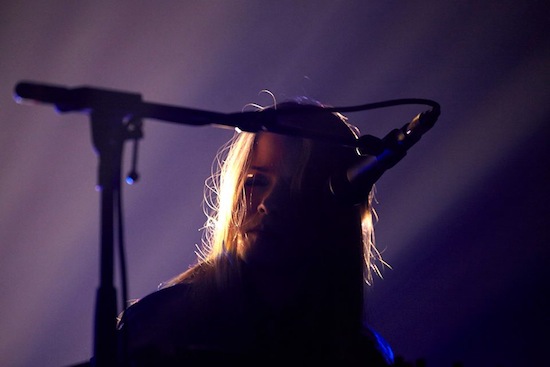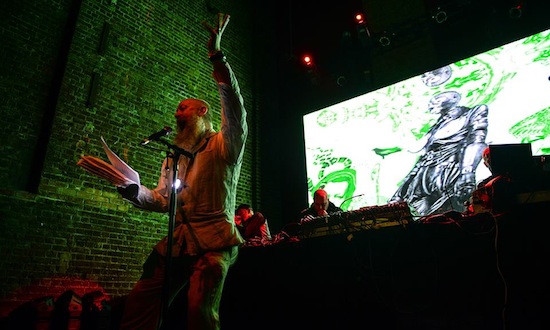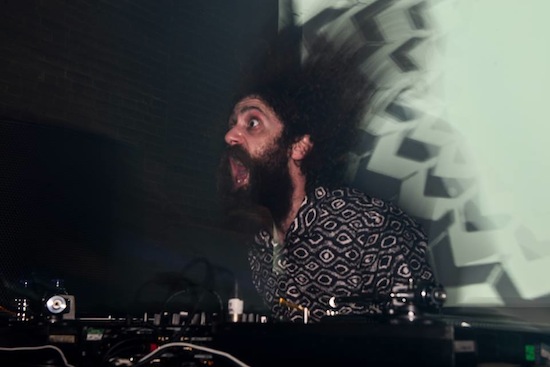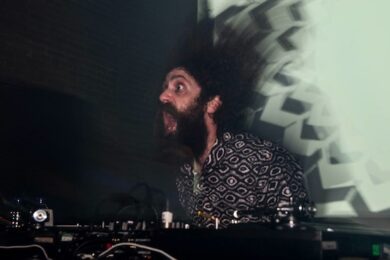The Gaslamp Killer Experience
"That’s the sound of California," declares William Benjamin Bensussen, after his crew trip through a new, cosmic synth-rock track that’s anchored by punishing beats and shrouded in quasi-mystical dread. Well, it’s one sound of California, certainly. A co-founder of hip LA club Low End Theory, The Gaslamp Killer reps for a west coast experimental scene that also features Flying Lotus, Kamasi Washington and Gonjasufi.
When he plays live in London, it’s often with Malcolm Catto’s jazz adventurers The Heliocentrics. But this time, the wild-haired DJ/producer has brought with him San Diego’s Drumetrics (previously Dirty Drums), and together they conjure a miasmatic hybrid of heavy instrumental hip hop, trippy electronics and psychedelic funk that connects King Tubby, Rage Against The Machine, DJ Shadow and the Brainfeeder crowd, with GK applying topspin via his Turkish heritage.
Set highlights are ‘Nissim’, a standout from his 2012 debut Breakthrough and two new tunes. One is a psych-rock monster described by GK as "’Nissim’ part two", which builds to a Comets On Fire-like blowout via overdriven, bouzouki-mimicking guitar. The other, ‘Shred You To Bits’, features an electric violin that saws away like a sweetly nagging toothache and is weighted by breastbone-cracking bass. Despite two tedious drum solos, an excess of "dope beats" patter and bro-style communing (the players are all introduced five times), the Experience’s spell holds. Sharon O’Connell
Laura Cannell
Laura Cannell’s best trick is to make proclamations like "This next one is based on a work by Guillaume de Machaut" without veering into Spinal Tap territory. That she follows these proclamations with understated, world-building pieces for solo instruments is an equally welcome surprise. With only a couple of violins and a couple of recorders, she is uniquely able to fuse inspiration with interpretation, delivering scintillating, programmatic works in miniature based on everything from Homerically florid psalms to the pioneering music of the 12th century apothecary, scientist and theologist Hildegard von Bingen. Obscurity is no boundary here.
These works, with Cannell as narrator and guide, do all the heavy lifting for the listener. It is our only duty to take it in as she hushes the Scala to a whisper with only a slackened overbow at her disposal. With two recorders in her mouth at once playing in remarkably even tones, Cannell comes across as a master builder of musical stories. Oh, and it should be noted that although the competition is fierce, her musical version of the Black Shuck legend is right up there with that of The Darkness. Daniel Ross

Anna von Hausswolff
I’m in a church. Plumes of back-lit dry ice are erupting from the centre of a makeshift stage in front of the altarpiece. Four serious-looking young men are working up a drone by way of solemn introduction. Then, in silhouette behind a raised bank of keyboards, a becowled figure appears and begins to nod furiously along to the booming pipe organ now filling the space. This is Anna von Hausswolff, and it’s fair to say she doesn’t do things by half-measure.
What follows is a show that’s both ludicrous and spectacular, rock theatre and ritual combined, ecclesiastical doom prog in extremis. Hausswolff’s playing is simple yet powerful, but her voice is a thing of elemental intensity, piercing the monolithic sound with screams of terror and ecstasy. The set leans heavily on last year’s The Miraculous, the songs alternating between ceremonial repetition and constant crescendo – ‘Come Wander With Me/Deliverance’ in particular hits a chord that sounds like one gigantic exclamation mark.
It’s not all sturm und drang though. For ‘Stranger’, Hausswolff leaves the safety of the stage to stalk the front pews before treating us to some balls-out interpretative dancing. Finally, she encores with a solo version of ‘Warszawa’, dedicated to "Our Bowie". Joe Banks
Factory Floor
I first saw Factory Floor back in 2014 after the release of their self-titled debut at an odd choice of venue; the ‘student friendly’, noughties hits go-to nightclub Coalition in Brighton. At this point, only a scattering of the seaside town’s original and long-dedicated ravers were on the case with this band, easily noted by the mark of some hi-vis gear here and there. Most likely because at this stage, Factory Floor were still a band setup, and this might have been confusing for fans of mainstream clubbing.
Prior to their Convergence set, I was still very much transfixed by this memory of them as a trio. Here, Factory Floor appear without Dominic Butler, with Nik Colk Void and Gabe Gurnsey as a duo now adapting this new dynamic for a slightly more conventional techno set. Colk’s vocals are nowhere to be found, and their usual pneumatic drill juddering no longer as central. A drum-kit is not needed though. At their peak during this performance, the propulsion and almost aggressive drive that originally set them off returns with stomach-fracking force through mere circuitry alone. With this as exemplar of their new material due for release in April, it is evident that Factory Floor are starting to shed their post-punk influences; they sound far more club-friendly here and it suits them well. Lottie Brazier
Colin Stetson
Sometimes, when people try to describe a musician who’s, y’know, "really into it," they call them shamanic. As in an actual shaman, a religious leader, a spiritual guide, presumably so swept up in it all that the lines between reality and the netherworld are blurred. They don’t just call them a great musician, because apparently that’s not enough. Well, Colin Stetson is, in all senses, a great musician and not a shaman. A shaman wouldn’t be able to put this much effort in.
Stetson’s devotion to his bass saxophone is symbiotic, intimate and strong, and throughout the four songs he plays we see him flex and alarmingly contort his body to facilitate their relationship. The sound is not religious, not shamanic. It is a Wellsian Martian tripod sending the masses screaming through Surrey, it is a raging, breaching beluga, it is a mash of vocal overtones, brilliantly indecent feedback and saliva-soaked, pad-clacking percussion. Stetson’s prowess is purely and beautifully physical, so much so that he half-jokingly complains of tendonitis between pieces and stretches his shoulder muscles contemplatively before embarking on the next, just like a human man would. There’s nothing shamanic about it – that’s why it’s so good. Daniel Ross

Nurse With Wound
NWW are as distinctive a feature on the UK’s avant-garde musical landscape as Ben Nevis is on its physical topography – and almost as venerable and craggy. Under founder Steven Stapleton’s decades-long directorship, a revolving door of collaborators has released countless albums and dodged genre definitions with every one.
Tonight’s set underlines the dichotomous character of NWW and how very off the "industrial" tag hung on the project is: it’s intense, but in no way noisily abrasive; beats as such are entirely absent; it’s improvised, often using toys and homemade instruments, but not one note is random; and humour is almost as important as horror. Against graphic back projections that mix the grotesque with the comic, the four principals – who include repeat NWW and Current 93 offender Andrew Liles – bend over guitar, bass, electronics and effects to conjure something sensational, in the true sense of the word.
Crafting one almost continuous, hour-long piece, they subtly shift pace, dynamics and mood, filling the room with unsettling malevolence one moment, an almost sweet, ambient drone pierced with birdsong, the next. A guest saxophonist casts mournful imprecations into the mix, while master of the surreal spoken word James Worse and brilliantly sinister cabaret MC Benjamin Louche add crucial narrative counterpoints.
It’s a(nother) compellingly eccentric one-off from a sonic institution with no need of a best-practice guide. Small wonder the (very) senior citizen positioned right down the front in her wheeled chair is filming it all on her iPad. Sharon O’Connell
Karen Gwyer
Convergence promised me an electronics lineup that included a marginally greater number of women than men, and I was delighted to take them up on it. Entering Shoreditch’s Village Underground, where this particular night was held, it was a relief to not be attacked by an almost tediously familiar wave of doom that accompanies feeling like an imposter in male spaces. As in, a sense of being an unwanted or unqualified presence in that particular space, that as female, has put me off attending heavily male techno events in the recent past. Moving along one sticky wall of the venue in a typical attempt to reach the stage, I see Karen Gwyer emerge to replace Kara Lis-Coverdale. Gwyer sports a beige cardigan and pleasingly looks the mirror opposite of the venue’s otherwise shady clientele. The night sees her supplement the infrequency of her shows in the UK with a highly consistent performance, propelled no doubt by the success of last year’s EP, Bouloman. This manifests itself through a long, well improvised experimental techno set which is of the most immersive and thumping kind that Gwyer has achieved so far. Here she indulges the audience, not only herself; she does not become caught up in predictable rhythms nor is reliant on repetition, knowing intuitively when to change dynamic and ignites her beats with dance-friendly swing. One is left, despite the adequate length of her set, feeling as if it was cut a bit short. Lottie Brazier



